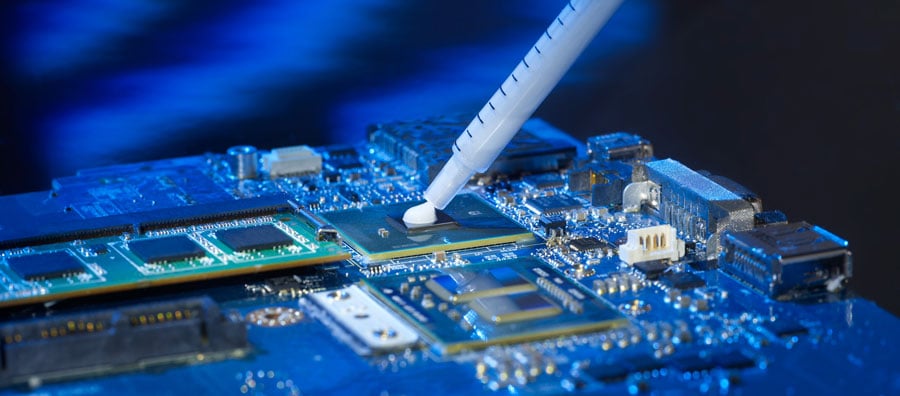As electronics become increasingly powerful, the heat being radiated is escalating in terms of what current cooling technology can handle.
Contact us
Sending Email...

SERVICES WE PROVIDE
Thermal management challenges
Managing the heat radiated by increasingly complex electronics is a growing issue in the automotive industry, particularly in hybrid and electric vehicles. Nolato Silikonteknik offers effective solutions in this field.
The entire global electronics industry faces significant challenges in thermal management. Demands are growing for higher-performing systems that can cope with more powerful software, faster data transfer rates in communications networks and internal data buses, all packaged in smaller, lighter devices. This means heat generation and, more crucially, heat density, is rapidly reaching the limits of what current thermal-management technology can handle.
For the automotive industry, these issues are compounded by the rapid evolution of vehicle electronics in general and hybrid and electric cars in particular.
Thermal issues specific to the front-end of automotive electronics include:
- Vehicle safety and ADAS. Advanced driver assistance systems (ADAS) govern active responses in brake and steering systems, as well as airbags and other safety features. Increasingly advanced sensor suites monitor activity around the vehicle in real time using radar, lidar, infrared and stereoscopic sensors. These sensors and, more importantly, the amount of data and the computations performed on it, require ever more powerful processors. But there can be no latency in these systems between event detection and response.
- Battery systems. Hybrid electric vehicles (HEVs) and battery electric vehicles (BEVs) rely on storing energy in batteries. However, battery systems are highly sensitive to variations in temperature. An inability to properly regulate the temperature in a battery pack will, at best, lead to the cells degrading too quickly and, at worst, result in a thermal runaway event that could cause a vehicle fire.
- Displays and infotainment. With traditional dashboards being replaced with digital screens and head-up displays (HUDs) and infotainment displays becoming larger and communicating vital vehicle information to the driver, displays have to maintain good visibility even in direct sunlight or other adverse viewing conditions. Such highly luminous displays inevitably generate heat, which needs to be removed.
- Electric drivetrain. It’s not only batteries that present thermal challenges in HEVs and BEVs. As power components have finite efficiency, running large amounts of power through them generates lots of heat. New developments are looking at doubling efficiency by using SiC semiconductors. However, as this also allows the volume of, for example, inverters and DC/DC converter devices to be cut by a factor of five, this is set to considerably exacerbate the overall thermal problem as this increases power density by up to 250%.
- Telecommunications. Development in the logistics of data storage and processing will be a key driver of how automotive electronics interacts with cloud, fog and edge computing.
- Autonomous vehicles. All of the above applies doubly to autonomous vehicles. Enabling true, full-scale autonomous driving systems will require taking the technology of the necessary systems and their thermal management to the next level.
Tailored thermal-management materials can make heat dissipation more efficient
In systems where liquid cooling and forced convection is available to move heat generated in electronics into the ambient environment, the major bottleneck in the heat transmission chain is the thermal interface between solid bodies, which the flow of heat is required to bridge. All the thermal problem areas listed above have multiple significant thermal interfaces.
Because assemblies always have tolerances, and normal industrially manufactured surfaces are never perfectly flat, attaching a heat source to a heat sink will always leave minute air gaps. And because air is a very good thermal insulator, these gaps create significant resistance to heat flow.
To mitigate this issue, the electronics industry uses thermal interface materials or ‘TIMs’. These materials fill the interfaces, displace the air and replace it with a compound that has better thermal conductivity by two to three orders of magnitude. It is in these materials that Nolato Silikonteknik’s expertise lies.
Nolato Silikonteknik offers a multitude of different types of TIM, tailored to the specifics of various applications, assemblies, and production environments.
In almost all conceivable user cases for these materials, the overarching goal is to minimize thermal resistance and create an assembly that allows the smallest possible drop in temperature in the specific circumstances of the design.
Developing these materials is an exacting science. It involves balancing the thermal properties necessary for the desired effect with mechanical and electrical properties, along with any other relevant design parameters such as aging, ease and speed of production. This requires a highly specific skillset. It includes understanding the properties of the polymer matrix, particle interactions and rheology (studying the flow and changing shape of matter), and how altering the proportions or process parameters in a mixture can affect a combination of these properties.

Thermal interface materials (TIM) in the form of pads or a paste displace air between electronics and the cooling component, substantially improving heat dissipation.
- Nolato Silikonteknik
- EMI shielding
- Thermal management
- EMC products
- Thermal Interface Materials
- Automotive
You might also be Interested in
SERVICE
Thermal interface materials and solutions
SERVICE
EMI shielding
GROUP COMPANY